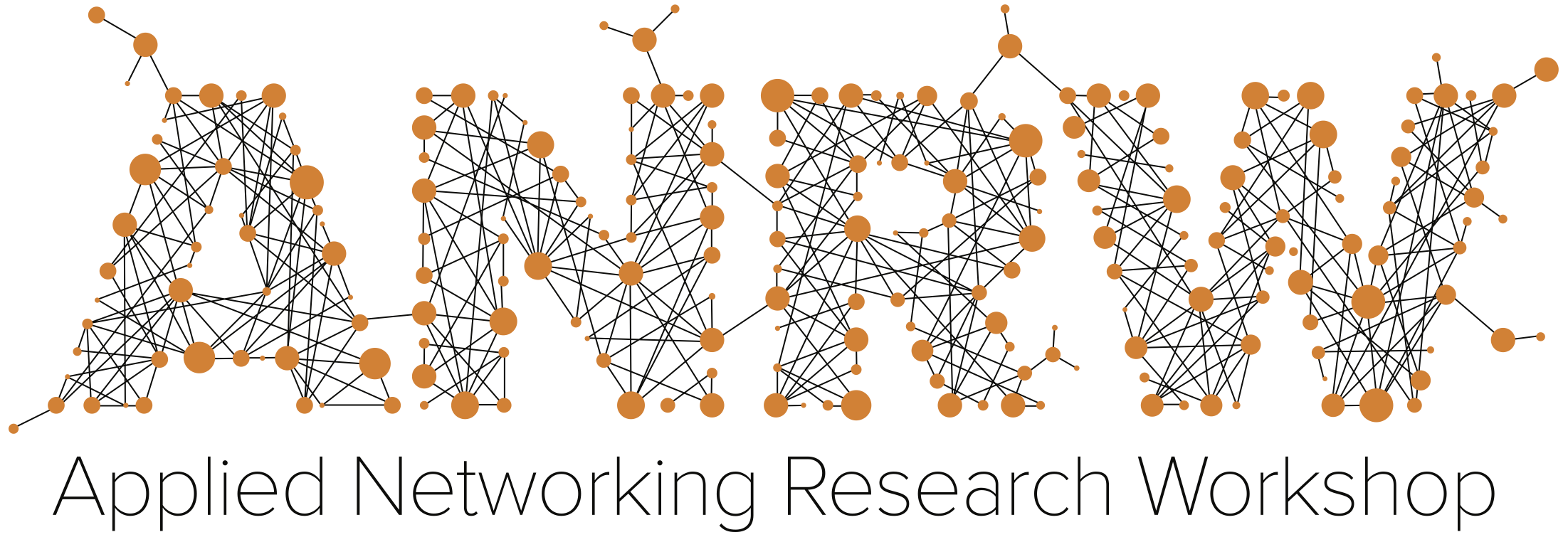|
9:15
|
Session: Multipath
An enhanced socket API for Multipath TCP
Benjamin Hesmans (UCL) and Olivier Bonaventure (UCL)
Slides
Multipath bonding at Layer 3.
Maciej Bednarek (ETH Zurich), Guillermo Barrenetxea Kobas
(Swisscom), Mirja Kühlewind (ETH Zurich), and Brian Trammell
(ETH Zurich).
Slides
Towards a Multipath TCP Aware Load Balancer
Simon Liénardy (Université de Liège) and Benoit Donnet (Université de Liège)
Multi-Homed on a Single Link: Using Multiple IPv6 Access Networks
Philipp S. Tiesel (TU-Berlin), Bernd May (TU-Berlin), and Anja
Feldmann (TU-Berlin).
|
|
10:45
|
Session: SDN, Routing and Peering
Towards Decentralized Fast Consistent Updates
Thanh Dang Nguyen (Université catholique de Louvain), Marco
Chiesa (Université catholique de Louvain), and Marco Canini
(Université catholique de Louvain)
Slides
Composition of SDN applications: Options/challenges for real implementations
Arne Schwabe (University of Paderborn), Pedro A. Aranda
Gutiérrez (Telefónica I+D), and Holger Karl (University of
Paderborn)
Slides
Towards Securing Internet eXchange Points Against Curious onlookers
Marco Chiesa (Université catholique de Louvain), Daniel Demmler
(Technische Universität Darmstadt), Marco Canini (Université
catholique de Louvain), Michael Schapira (Hebrew University of
Jerusalem), and Thomas Schneider (Technische Universität
Darmstadt).
Slides
Computing Customer Cones of Peering Networks
Jinu Susan Varghese (Iowa State University) and Lu Ruan (Iowa
State University)
|
|
13:00
|
Session: Transport Quality and “Happy Eyeballs”
Measuring the Effects of Happy Eyeballs
Vaibhav Bajpai (Jacobs University Bremen) and Jürgen
Schönwälder (Jacobs University Bremen)
Slides
On the Cost of Using Happy Eyeballs for Transport Protocol Selection
Giorgos Papastergiou (Simula Research Laboratory), Karl-Johan
Grinnemo (Karlstad University), Anna Brunstrom (Karlstad
University), David Ros (Simula Research Laboratory), Michael
Tüxen (Fachhochschule Münster), Naeem Khademi (University of
Oslo), and Per Hurtig (Karlstad University)
Slides
Start Me Up: Determining and Sharing TCP’s Initial Congestion Window
Safiqul Islam (University of Oslo) and Michael Welzl
(University of Oslo)
Slides
|
|
14:05
|
Session: Measurement
Revisiting Benchmarking Methodology for Interconnect Devices
Daniel Raumer (Technical University of Munich), Sebastian
Gallenmüller (Technical University of Munich), Florian Wohlfart
(Technical University of Munich), Paul Emmerich (Technical
University of Munich), Patrick Werneck (Technical University of
Munich), and Georg Carle (Technical University of Munich)
Slides
PATHspider: A tool for active measurement of path transparency
Iain R. Learmonth (University of Aberdeen), Brian Trammell (ETH
Zurich), Mirja Kuhlewind (ETH Zurich), and Gorry Fairhurst
(University of Aberdeen)
Slides
Diurnal and Weekly Cycles in IPv6 Traffic
Stephen D. Strowes (Yahoo)
Slides
How to say that you’re special: Can we use bits in the IPv4 header?
Runa Barik (University of Oslo, Norway), Michael Welzl
(University of Oslo, Norway), and Ahmed Elmokashfi (Simula
Research Laboratory, Norway)
Slides
Towards an Observatory for Network Transparency Research
Stephan Neuhaus (Zürcher Hochschule für Angewandte
Wissenschaften), Roman Müntener (Zürcher Hochschule für
Angewandte Wissenschaften), Korian Edeline (Université de
Liège), Benoit Donnet (Université de Liège), and Elio Gubser
(ETH Zurich)
|
|
15:45
|
Session: Internet Media
Making Google Congestion Control robust over Wi-Fi networks
using packet grouping
Gaetano Carlucci (Politecnico di Bari, Italy), Luca De Cicco
(Politecnico di Bari, Italy), Stefan Holmer (Google Inc,
Sweden), and Saverio Mascolo (Politecnico di Bari, Italy).
Slides
Implementing Real-Time Transport Services over an Ossified Network
Stephen McQuistin (University of Glasgow), Colin Perkins
(University of Glasgow), and Marwan Fayed (University of
Stirling)
Slides
|

